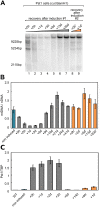Selective mitochondrial DNA degradation following double-strand breaks
- PMID: 28453550
- PMCID: PMC5409072
- DOI: 10.1371/journal.pone.0176795
Selective mitochondrial DNA degradation following double-strand breaks
Abstract
Mitochondrial DNA (mtDNA) can undergo double-strand breaks (DSBs), caused by defective replication, or by various endogenous or exogenous sources, such as reactive oxygen species, chemotherapeutic agents or ionizing radiations. MtDNA encodes for proteins involved in ATP production, and maintenance of genome integrity following DSBs is thus of crucial importance. However, the mechanisms involved in mtDNA maintenance after DSBs remain unknown. In this study, we investigated the consequences of the production of mtDNA DSBs using a human inducible cell system expressing the restriction enzyme PstI targeted to mitochondria. Using this system, we could not find any support for DSB repair of mtDNA. Instead we observed a loss of the damaged mtDNA molecules and a severe decrease in mtDNA content. We demonstrate that none of the known mitochondrial nucleases are involved in the mtDNA degradation and that the DNA loss is not due to autophagy, mitophagy or apoptosis. Our study suggests that a still uncharacterized pathway for the targeted degradation of damaged mtDNA in a mitophagy/autophagy-independent manner is present in mitochondria, and might provide the main mechanism used by the cells to deal with DSBs.
Conflict of interest statement
Figures




References
MeSH terms
Substances
LinkOut - more resources
Full Text Sources
Other Literature Sources

